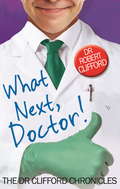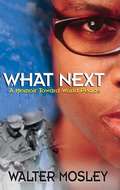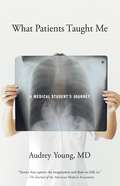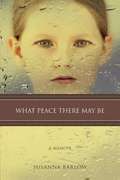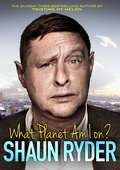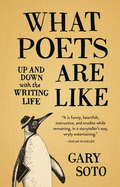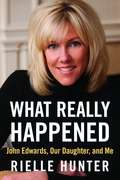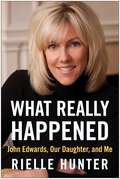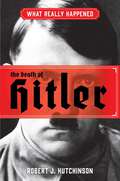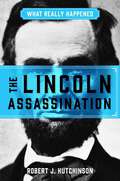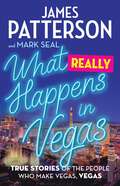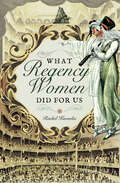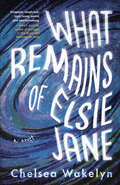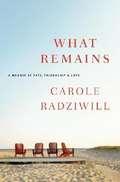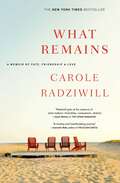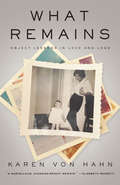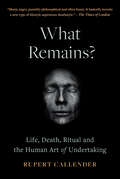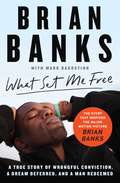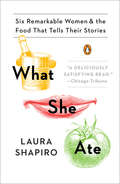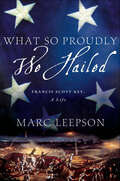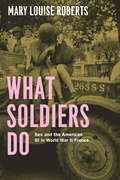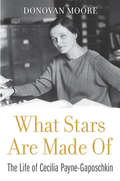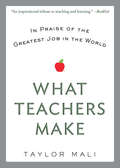- Table View
- List View
What Next, Doctor?
by Robert CliffordWhat Next Doctor? is the third book in the hilarious Dr Clifford Chronicles, true-life experiences as G.P. in a West Country practice. This instalment commences when Dr Clifford and his bride wake up to a bizarre confrontation on the first day of their honeymoon - and promptly prescribe themselves champagne as a cure! The patients passing through his life are by turns comic and courageous, lovable and tragic. There's the long-married couple whose recipe for happiness is a row twice a week; the accident- prone ex- miner whose collection of injuries and ailments makes him a medical curiosity; and the elderly couple who turn out to be mother and son - the son is eighty-one! Dr Clifford presents us with an immensely entertaining slice of life- the tragedies and triumphs of ordinary people caught up in the human drama of survival in a world of sickness and ill health. And he tells his tale with all warmth and humour that makes his books a real delight to read.
What Next, Doctor? (The Dr Clifford Chronicles)
by Dr Robert CliffordWhat Next Doctor? is the third book in the hilarious Dr Clifford Chronicles, true-life experiences as G.P. in a West Country practice. This instalment commences when Dr Clifford and his bride wake up to a bizarre confrontation on the first day of their honeymoon - and promptly prescribe themselves champagne as a cure! The patients passing through his life are by turns comic and courageous, lovable and tragic. There's the long-married couple whose recipe for happiness is a row twice a week; the accident- prone ex- miner whose collection of injuries and ailments makes him a medical curiosity; and the elderly couple who turn out to be mother and son - the son is eighty-one!Dr Clifford presents us with an immensely entertaining slice of life- the tragedies and triumphs of ordinary people caught up in the human drama of survival in a world of sickness and ill health. And he tells his tale with all warmth and humour that makes his books a real delight to read.
What Next: An African American Initiative Toward World Peace
by Walter MosleyBestselling author of mysteries and other novels challenges African Americans to take a decisive role in bringing about world peace.
What Patients Taught Me: A Medical Student's Journey
by Audrey YoungDo sleek high-tech hospitals teach more about medicine and less about humanity? Do doctors ever lose their tolerance for suffering? With sensitive observation and graceful prose, this book explores some of the difficult and deeply personal questions a 23-year-old doctor confronts with her very first dying patient, and continues to struggle with as she strives to become a good doctor. In her travels, the doctor attends to terminal illness, AIDS, tuberculosis, and premature birth in small rural communities throughout the world.
What Peace There May Be: A Memoir
by Susanna Barlow<p>Young Susanna doesn't know anything other than the family environment that has been created for her, a system without regard for society or man's laws. Raised in a sequestered home in a busy city neighborhood, everything beyond the front gate is off-limits. <p>The isolation proves to be a breeding ground for abuse, and Susanna struggles to reconcile her desire to escape and her need to belong. The book recounts six critical years in Susanna's life as she comes to terms with her conditions. <p>This story is as much a testament to survival as it is to surrender. Pushed to the limits of her coping abilities, Susanna tries anything to bring about the peace that seems always out of reach. In an impulsive moment and an act of daring she contacts a newspaper journalist and finds herself in a predicament she never before considered. That decision becomes the impetus that propels her finally to where she wants to be.</p>
What Planet Am I On?
by Shaun Ryder'I think anyone who doesn't believe there is life out there will eventually end up looking as ignorant as those people who used to think that the earth was flat and if you went too far out to sea in your boat you'd fall off the end of the world. Ridiculous.' Shaun Ryder goes in search of his secret passion: extra-terrestrials. Travelling the world over to discover the truth about UFOs, and whether there really is life out there, Shaun encounters ancient tribes, fellow believers and leading specialists, all the while attempting to detect fact from fiction.Ever since he saw a UFO at the age of fifteen, Ryder has been a fervent believer. He begins with the spike in paranormal activity which Manchester experienced during his childhood in the late 70s. From his hometown Shaun travels to the top secret Area 51, to the Mayan ruins of Peru and Chile and to aboriginal caves in Australia, exploring the UFO capitals of the world. He also speaks to experts like Professor Steven Hawking, and famous UFO enthusiasts like Robbie Williams and Dan Ackroyd.A deeply funny, revelatory travelogue, Shaun Ryder on UFOs is a unique personal insight into a fantastic journey of discovery.Praise for Twisting My Melon:'Intoxicating: swaggering, cringing, furious, vulnerable, chaotic, bilious, funny, mad. A seamless, authentic, exhilarating read, without a single slack paragraph.' Sunday Times.'At once poignant and hilarious.' Word Magazine.'Highly entertaining.'Independent on Sunday.'A welcome contrast to the current trend of macho post-rehab confessions by tedious hard-rock narcissists.' Guardian.
What Poets Are Like
by Gary SotoGary Soto is a widely published author of children's and young adult fiction, and he is an acclaimed poet--often referred to as one of the nation's first Chicano poets. With a sharp sense of storytelling and a sly wit, What Poets Are Like is a memoir of the writing life that shares the keen observation, sense of self and humor of such writers as Sherman Alexie and Nora Ephron.In some 60 short episodes, this book captures moments of a writer's inner and public life, close moments with friends and strangers, occasional reminders of a poet's generally low place in the cultural hierarchy; time spent with cats; the curious work of writing. He tells the stories of his time spent in bookstores and recounts the glorious, then tragic, arc of Cody's Bookstore in Berkeley, ending with the author whose scheduled event fell on the day after the business shut down, but who stood outside the locked door and read aloud just the same. As all writers do, Soto suffers the slings and arrows of rejection, often from unnamed Midwest poetry journals, and seeks the solace of a friendly dog at such moments. Soto jabs at the crumbs of reward available to writers--a prize nomination here, a magazine interview there--and notes the toll they take on a frail ego. The pleasure Soto takes in the written word, a dose of comic relief plus his appreciation of the decisive moment in life make this an engaging and readable writer's confession.
What Really Happened: John Edwards, Our Daughter, and Me
by Rielle HunterThe John Edwards-Rielle Hunter affair made headlines for years. "One of the biggest political scandals of all time," "a fall from grace," "a modern-day tragedy" - it's a story that has been reported, distorted, and spun over and over again by the media, by political aides, by the U. S. government, by supposed friends. However, there is someone who actually knows the truth, someone who lived it from day one-the woman at the heart of the story itself: Rielle Hunter. In What Really Happened, Hunter offers an extremely personal account of her relationship with John Edwards: the facts of how they actually met, how their accidental love started and escalated, what it was like to fall in love with a married man who decided to run for president, the surprise of becoming pregnant during the campaign, how the affair became public, the extensive cover-up, and finally, what happened in the years after Edwards publicly admitted to being the father of their daughter, Frances Quinn. Meet Edwards's political players and get an intimate look at how they really operated. Learn about the evolution of "friends," enablers, and do-gooders, their involvement with the affair and Edwards's 2008 presidential campaign, and where the money from Rachel "Bunny" Mellon and Fred Baron actually went. This book doesn't spin the truth to achieve a prettier picture or a better story. It isn't about changing anyone's mind. It's simply the facts, the truth of what really happened.
What Really Happened: John Edwards, Our Daughter, and Me
by Rielle HunterThe John Edwards–Rielle Hunter affair made headlines for years. "One of the biggest political scandals of all time," "a fall from grace," "a modern-day tragedy"—it's a story that has been reported, distorted, and spun over and over again by the media, by political aides, by the U.S. government, by supposed friends. However, there is someone who actually knows the truth, someone who lived it from day one—the woman at the heart of the story itself: Rielle Hunter. In the New York Times, Wall Street Journal, and Publishers Weekly bestseller What Really Happened, Hunter offers an extremely personal account of her relationship with John Edwards: the facts of how they actually met, how their accidental love started and escalated, what it was like to fall in love with a married man who decided to run for president, the surprise of becoming pregnant during the campaign, how the affair became public, the extensive cover-up, and finally, what happened in the years after Edwards publicly admitted to being the father of their daughter, Frances Quinn. Meet Edwards's political players and get an intimate look at how they really operated. Learn about the evolution of "friends," enablers, and do-gooders, their involvement with the affair and Edwards's 2008 presidential campaign, and where the money from Rachel "Bunny" Mellon and Fred Baron actually went. This book doesn't spin the truth to achieve a prettier picture or a better story. It isn't about changing anyone's mind. It's simply the facts, the truth of what really happened.
What Really Happened: The Death of Hitler
by Robert J. HutchinsonThink You Know Everything about the death of Hitler? Think Again. After World War II, 50 percent of Americans polled said they didn&’t believe Adolf Hitler and Eva Braun had committed suicide in their bunker in 1945, as captured Nazi officials claimed. Instead, they believed the dictator faked his death and escaped, perhaps to Argentina. This wasn&’t a crazy opinion: Joseph Stalin told Allied leaders that Soviet forces never discovered Hitler&’s body and that he personally believed the Nazi leader had escaped justice. At least two German submarines crossed the Atlantic and landed on the coast of Argentina in July 1945. Plus, there were numerous reports of top Nazi officials successfully fleeing to South America where there was a large German colony. Incredible as it sounds, the mystery surrounding Adolf Hitler&’s final days only deepened in 2009 when a U.S. forensic team announced that a piece of Hitler&’s skull held in Soviet archives was not actually Hitler&’s. International interest increased further in 2014 when the FBI released previously classified files detailing investigations surrounding Hitler&’s possible escape. And the following year, The History Channel launched a three-year reality TV series investigating if it was possible Hitler did somehow survive. So what really happened? Popular history writer Robert J. Hutchinson, author of What Really Happened: The Lincoln Assassination, takes a fresh look at the evidence and discovers, once and for all, the truth about Hitler&’s last week in Berlin. Among the questions the book explores are... * What did surviving Nazi eyewitnesses really say about the Führer&’s final days in the bunker—and could they have been lying to aid Hitler&’s escape? * If Hitler didn&’t escape, why did the Allies not find his body? * What about Hitler&’s proven use of body doubles? Could Hitler have used a body double in the bunker while he and Eva Braun flew to safety in a long-range aircraft that took off from a runway in Berlin&’s Tiergarten? * Why did the FBI continue to investigate reports of Hitler&’s survival for more than a decade after World War II—reports that were only declassified in 2014? * What about sensational claims in books such as The Grey Wolfthat Hitler and Eva Braun lived in an isolated chalet in the Andes – and that Hitler died in 1962? * Why were forensic tests on crucial physical evidence only conducted in 2016, more than 70 years after World War II ended? * And lots MORE.
What Really Happened: The Lincoln Assassination
by Robert J. HutchinsonThink You Know Everything about the Lincoln Assassination? Think Again. After 150 years, many unsolved mysteries and enduring urban legends still surround the assassination of Abraham Lincoln by the popular stage actor John Wilkes Booth. In a new look at the case, award-winning history author Robert J. Hutchinson (The Politically Incorrect Guide to the Bible) explores what we know, and don&’t know, about what really happened at Ford&’s Theatre on the night of April 14, 1865. In addition, he argues that the deep-seated political hatreds that roiled Washington, D.C., in the final weeks of the Civil War are particularly relevant to our own polarized age. Among the tantalizing questions Hutchinson explores are: * Did the Confederacy have a hand in the assassination plot? * Who were Booth&’s secret accomplices, and why did he change the plan from kidnapping to assassination? * Why was it so easy for Booth to walk into the president&’s box to shoot him? Where were the guards? * How did Booth evade the largest manhunt in U.S. history for nearly two weeks despite being unable to walk? * Who gave the order to shoot Booth in the Garrett barn—and what happened to his body? Drawing upon both primary sources and the best recent historical research, What Really Happened: The Lincoln Assassination separates established facts from mere conjectures—and is the one book to own if you want to know &“what really happened.&” Also look for the second book in the series: What Really Happened: The Death of Hitler, coming August 2020.
What Really Happens in Vegas: True Stories of the People Who Make Vegas, Vegas
by James Patterson Mark SealWhat happens in Vegas stays in Vegas—until now. James Patterson shows the real Vegas in a dazzling journey through &“lively tales of those who labor and dream in Sin City" (Kirkus). &“Wild and wonderful…The magic of Sin City doesn&’t just happen. Patterson and Seal tell its secrets in beautifully presented snippets that often overlap not just surprisingly, but charmingly too.&” —Telegraph (UK) Las Vegas is on Luxury Standard Time: every clock in the airport is a Rolex. No dream is too big, no wish is too small—the VIP hosts in Vegas fulfill guests&’ every (legal) desire. Jackpots hit when least expected. The Nevada Gaming Control Board has days to find a man who unknowingly won over $200,000 at the slots. &“I love love&”: the inventor of the Elvis impersonator wedding and the drive-thru wedding has performed hundreds of marriages—and believes in them all. Glamorous yogis take a helicopter across the desert to the Valley of Fire, where they perform sun salutations to the glory of Las Vegas. A gambling VIP &“whale&” loses $1 million at the casinos, yet still leaves saying, "Had a great time. I'll be back." In What Really Happens in Vegas, full of surprises for both newcomers and Las Vegas regulars, James Patterson and Vanity Fair contributing editor Mark Seal transport readers from the thrill of adrenaline-fueled vice to the glitter of A-list celebrity and entertainment.
What Regency Women Did for Us
by Rachel KnowlesProfiles of twelve trailblazing Regency Era women—from Jane Austen to Madame Tussaud—who took charge of their destinies and changed the world. In the nineteenth century, women faced challenges and constraints that many of us would find shocking by today&’s standards. What Regency Women Did for Us tells the inspirational stories of twelve women who overcame entrenched institutional obstacles to achieve trailblazing success—women such as the German astronomer Caroline Herschel, who discovered a comet that bears her name; the French artist Marie Tussaud whose wax sculptures made her world famous; the great author Jane Austen whose novels continue to delight generations of readers. These women were pioneers, philanthropists, entrepreneurs, authors, scientists, and actresses—women who made an impact on their world and ours. Popular history blogger Rachel Knowles tells how each of these women challenged the limitations of their time and left an enduring legacy for future generations to follow. Two hundred years later, their stories remain powerful inspirations for us all. &“Rachel&’s fine book looks at how the women of Britain emerged from the shadows of their husbands during the Regency period, inspiring female writers, scientists, etc. to take hold of their own destinies and start to have an influence on the world. Brilliant.&” —Books Monthly
What Remains of Elsie Jane
by Chelsea Wakelyn“A poignant, laugh-out-loud funny, weird, and heartbreaking window into being bereft and being in love… a striking reminder that there can be beauty in devastation.” — EMILY AUSTIN, author of Everyone in This Room Will Someday Be DeadA heartbreaking and darkly funny portrait of a woman unravelling in the wake of tragedy.Sam is dead, which means that Elsie Jane has just lost the brilliant, sensitive man she planned to grow old with. The early days of grief are a fog of work and single parenting. Too restless to sleep, Elsie pores over Sam’s old love letters, paces her house, and bickers with the ghosts of Sam and her dead parents night after night. As the year unfolds, she develops an obsession with a local murder mystery, attends a series of disastrous internet dates in search of a “replacement soulmate,” and solicits a space-time wizard via Craigslist, convinced he will help her forge a path through the cosmos back to Sam.Examining the ceaseless labour of motherhood, the stigma of death by drug poisoning, and the allure of magical thinking in the wake of tragedy, What Remains of Elsie Jane is a heart-splitting reminder that grief is born from the depths of love.A RARE MACHINES BOOK
What Remains: A Memoir of Fate, Friendship, and Love
by Carole RadziwillMemoir about a girl from a working-class town who becomes an award-winning television producer and marries a prince, part fairy tale, part tragedy.
What Remains: A Memoir of Fate, Friendship, and Love
by Carole RadziwillA stunning, tragic memoir about John F. Kennedy Jr., his wife Carolyn Bessette-Kennedy, and his cousin Anthony Radziwill, by Radziwill&’s widow.What Remains is a vivid and haunting memoir about a girl from a working-class town who becomes an award-winning television producer and marries a prince, Anthony Radziwill. Carole grew up in a small suburb with a large, eccentric cast of characters. At nineteen, she struck out for New York City to find a different life. Her career at ABC News led her to the refugee camps of Cambodia, to a bunker in Tel Aviv, and to the scene of the Menendez murders. Her marriage led her into the old world of European nobility and the newer world of American aristocracy. What Remains begins with loss and returns to loss. A small plane plunges into the ocean carrying John F. Kennedy Jr., Anthony&’s cousin, and Carolyn Bessette Kennedy, Carole&’s closest friend. Three weeks later Anthony dies of cancer. With unflinching honesty and a journalist&’s keen eye, Carole Radziwill explores the enduring ties of family, the complexities of marriage, the importance of friendship, and the challenges of self-invention. Beautifully written, What Remains &“gets at the essence of what matters,&” wrote Oprah Winfrey. &“Friendship, compassion, destiny.&”
What Remains: Object Lessons in Love and Loss
by Karen Von HahnA funny, poignant, and at times heartbreaking memoir about one mother and her love of beautiful objets — and how it ultimately proved destructive.Being left with a strand of even the highest quality milky-white pearls isn’t quite the same thing as pearls of wisdom to live by, as Karen von Hahn reveals in her memoir about her stylish and captivating mother, Susan — a mercurial, grandiose, Guerlain-and-vodka-soaked narcissist whose search for glamour and fulfillment through the acquisition and collection of beautiful things ultimately proved hollow.A tale of growing up in 1970s and 1980s Toronto in the fabulousness of a bourgeois Jew-ish family that valued panache over pragmatism and making a design statement over substance, von Hahn’s recollections of her dramatic and domineering mother are exemplified by the objects she held most dear: from a strand of prized pearls, to a Venetian mirror worthy of the palace of Versailles, to the silver satin sofas that were the epitome of her signature style. She also describes the misunderstandings and sometimes hurt and pain that come with being raised by her stunning, larger-than-life mother who in many ways embodied the flash-and-glam, high-flying, wealth-accumulating generation that gave birth to our modern-day material culture.Alternating between satire and sadness, von Hahn reconstructs the past through a series of exquisitely impressionistic memories, ultimately questioning the value of the things we hold dear and — after her complicated, yet impossible-to-forget mother is gone — what exactly remains.
What Remains?: Life, Death and the Human Art of Undertaking
by Rupert Callender‘This book is a great work of craft and beauty.’ Salena Godden ‘This compelling personal story of a pioneering punk undertaker is a moving revelation.’ Love Reading ‘Inspiring and unforgettable.’ John Higgs, author of William Blake vs the World Death has shown me...the unbreakable core of love and courage that lies at the heart of what it means to be human. Ru Callender wanted to become a pioneering undertaker in order to offer people a more honest experience than the stilted formality of traditional ‘Victorian’ funerals. Driven by raw emotion and the unresolved grief of losing his own parents, Ru brought an outsider, ‘DIY’ ethos to the business of death, combined with the kinship and inspiration he found in rave culture, social outlaws and political nonconformists. Ru has carried coffins across windswept beaches, sat in pubs with caskets on beer-stained tables, helped children fire flaming arrows into their father’s funeral pyre, turned modern occult rituals into performance art and, with the band members of the KLF, is building the People’s Pyramid of bony bricks in Liverpool – all in the name of creating truly authentic experiences that celebrate those who are no longer here and those who remain. Radical, poignant, unflinchingly real and laugh-aloud funny, What Remains? will change the way you think about life, death and the human experience.
What Set Me Free (The Story That Inspired the Major Motion Picture Brian Banks): A True Story of Wrongful Conviction, a Dream Deferred, and a Man Redeemed
by Brian BanksBrian Banks, the major motion picture starring Aldis Hodge, Greg Kinnear, and Sherri Shepherd, winner of the audience award at the 2018 LA Film Festival, opens nationwide in 2019! Discover the unforgettable and inspiring true story of Brian Banks—a young man who was wrongfully convicted as a teenager and imprisoned for more than five years, only to emerge with his spirit unbroken and determined to achieve his dream of playing in the NFL.At age sixteen, Brian Banks was a nationally recruited All-American Football player, ranked eleventh in the nation as a linebacker. Before his seventeenth birthday, he was in jail, awaiting trial for a heinous crime he did not commit. Although Brian was innocent, his attorney advised him that as a young black man accused of rape, he stood no chance of winning his case at trial. Especially since he would be tried as an adult. Facing a possible sentence of forty-one years to life, Brian agreed to take a plea deal—and a judge sentenced him to six years in prison. At first, Brian was filled with fear, rage, and anger as he reflected on the direction his life had turned and the unjust system that had imprisoned him. Brian was surrounded in darkness, until he had epiphany that would change his life forever. From that moment on, Brian made the choice to shed the bitterness and anger he felt, and focus only on the things he had the power to control. He approached his remaining years in prison with a newfound resolve, studying and applying spirituality, improving his social and writing skills, and taking giant leaps on his journey toward enlightenment. When Brian emerged from prison with five years of parole still in front of him, he was determined to re-build his life and finally prove his innocence. Three months before his parole was set to expire, armed with a shocking recantation from his accuser and the help of the California Innocence Project, the truth about his unjust incarceration came out and he was exonerated. Finally free, Brian sought to recapture a dream once stripped away: to play for the NFL. And at age twenty-eight, he made that dream come true. Perfect for fans of Just Mercy, I Beat the Odds, and Infinite Hope, this powerful memoir is a deep dive into the injustices of the American justice system, a soul-stirring celebration of the resilience of the human spirit, and an inspiring call to hold fast to our dreams.
What She Ate: Six Remarkable Women and the Food That Tells Their Stories
by Laura Shapiro"A collection of deft portraits in which food supplies an added facet to the whole.”—Slate“Mouthwatering.”—Eater.com A beloved culinary historian’s short takes on six famous women through the lens of food and cooking—what they ate and how their attitudes toward food offer surprising new insights into their lives.Everyone eats, and food touches on every aspect of our lives—social and cultural, personal and political. Yet most biographers pay little attention to people’s attitudes toward food, as if the great and notable never bothered to think about what was on the plate in front of them. Once we ask how somebody relates to food, we find a whole world of different and provocative ways to understand her. Food stories can be as intimate and revealing as stories of love, work, or coming-of-age. Each of the six women in this entertaining group portrait was famous in her time, and most are still famous in ours; but until now, nobody has told their lives from the point of view of the kitchen and the table. It’s a lively and unpredictable array of women; what they have in common with one another (and us) is a powerful relationship with food. They include Dorothy Wordsworth, whose food story transforms our picture of the life she shared with her famous poet brother; Rosa Lewis, the Edwardian-era Cockney caterer who cooked her way up the social ladder; Eleanor Roosevelt, First Lady and rigorous protector of the worst cook in White House history; Eva Braun, Hitler’s mistress, who challenges our warm associations of food, family, and table; Barbara Pym, whose witty books upend a host of stereotypes about postwar British cuisine; and Helen Gurley Brown, the editor of Cosmopolitan, whose commitment to “having it all” meant having almost nothing on the plate except a supersized portion of diet gelatin.
What So Proudly We Hailed: Francis Scott Key, A Life
by Marc LeepsonWhat So Proudly We Hailed is the first full-length biography of Francis Scott Key in more than 75 years. In this fascinating look at early America, historian Marc Leepson explores the life and legacy of Francis Scott Key. Standing alongside Betsy Ross, Thomas Paine, Patrick Henry, Paul Revere, and John Hancock in history, Key made his mark as an American icon by one single and unforgettable act, writing "The Star-Spangled Banner." Among other things, Leepson reveals:• How the young Washington lawyer found himself in Baltimore Harbor on the night of September 13-14, 2014• The mysterious circumstances surrounding how the poem he wrote, first titled "The Defense of Ft. M'Henry," morphed into the National Anthem• Key's role in forming the American Colonization Society, and his decades-long fervent support for that controversial endeavor that sent free blacks to Africa• His adamant opposition to slave trafficking and his willingness to represent slaves and freed men and women for free in Washington's courts• Key's role as a confidant of President Andrew Jackson and his work in Jackson's "kitchen cabinet"• Key's controversial actions as U.S. Attorney during the first race riot in Washington, D.C., in 1835. Publishing to coincide with the 200th anniversary of "The Star Spangled Banner" in 2014, What So Proudly We Hailed reveals unexplored details of the life of an American patriot whose legacy has been largely unknown until now.
What Soldiers Do: Sex and the American GI in World War II France
by Mary Louise RobertsHow do you convince men to charge across heavily mined beaches into deadly machine-gun fire? Do you appeal to their bonds with their fellow soldiers, their patriotism, their desire to end tyranny and mass murder? Certainly—but if you’re the US Army in 1944, you also try another tack: you dangle the lure of beautiful French women, waiting just on the other side of the wire, ready to reward their liberators in oh so many ways. That’s not the picture of the Greatest Generation that we’ve been given, but it’s the one Mary Louise Roberts paints to devastating effect in What Soldiers Do. Drawing on an incredible range of sources, including news reports, propaganda and training materials, official planning documents, wartime diaries, and memoirs, Roberts tells the fascinating and troubling story of how the US military command systematically spread—and then exploited—the myth of French women as sexually experienced and available. The resulting chaos—ranging from flagrant public sex with prostitutes to outright rape and rampant venereal disease—horrified the war-weary and demoralized French population. The sexual predation, and the blithe response of the American military leadership, also caused serious friction between the two nations just as they were attempting to settle questions of long-term control over the liberated territories and the restoration of French sovereignty. While never denying the achievement of D-Day, or the bravery of the soldiers who took part, What Soldiers Do reminds us that history is always more useful—and more interesting—when it is most honest, and when it goes beyond the burnished beauty of nostalgia to grapple with the real lives and real mistakes of the people who lived it.
What Stars Are Made Of: The Life of Cecilia Payne-Gaposchkin
by Donovan MooreCecilia Payne-Gaposchkin was the revolutionary scientific thinker who discovered what stars are made of. But her name is hard to find alongside those of Hubble, Herschel, and other great astronomers. Donovan Moore tells the story of Payne-Gaposchkin’s life of determination against all the obstacles a patriarchal society erected against her.
What Teachers Make
by Taylor MaliIn praise of the greatest job in the world... The right book at the right time: an impassioned defense of teachers and why we need them now more than ever. Teacher turned teacher's advocate Taylor Mali inspired millions with his original poem "What Teachers Make," a passionate and unforgettable response to a rich man at a dinner party who sneeringly asked him what teachers make. Mali's sharp, funny, perceptive look at life in the classroom pays tribute to the joys of teaching...and explains why teachers are so vital to our society. What Teachers Make is a book that will be treasured and shared by every teacher in America--and everybody who's ever loved or learned from one.
What The Buddha Taught
by Walpola Sri RahulaScholar outlines Buddhist practice referring to writings from Chinese and Tibetan manuscripts not available in English translation.
